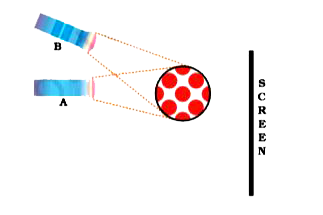
The solid so formed by joining unit cubes is rotated to obtain different positions, which of these cannot be the shape after it has turned?

The correct Answer is:C
The shape given in the option (3) is not appropriate.
Topper's Solved these Questions
- CUBES AND DICEBOOK - KIRAN PUBLICATIONCHAPTER - CUBES AND DICEEXERCISE - TYPE-II
120 Videos
- COMPLETION OF FIGURE BOOK - KIRAN PUBLICATIONCHAPTER - COMPLETION OF FIGURE EXERCISE - MULTIPLE CHOICE QUESTIONS
271 Videos
- DEVIATION OF FIGURE BOOK - KIRAN PUBLICATIONCHAPTER - DEVIATION OF FIGURE EXERCISE - MULTIPLE CHOICE QUESITONS
7 Videos
Similar Questions
A torch is placed at two different positions A and B, one by one, as shown in Fig. 11.9.

The shape of the shadow obtained in two positions is shown in Fig. 11.10

Match the position of the torch and shape of the shadow of the ball.
View SolutionA right triangle ABC with its sides 5 cm, 12cm and 13cm is revolved about the side 12cm. Find the volume of the solid so formed. If the triangle ABC is revolved about side 5cm, then find the volume of the solid so obtained. Find also the ratio of the volumes of the two solids obtained.
View Solution
Knowledge Check
Which of the following has a shape different from others?
APCl3BNH3CPH3DBF3If the cone is cut along its axis from the middle , the new shape we obtain after opening the paper is :
Aisosceles triangleBequilateral triangleCright angle triangleDnone of theseWhich of the following has a shape different from others ?
A[Zn(NH3)4]2+BNi(CO)4C[Cd(CN)4]2−D[Cu(NH3)4]2+
The solid cuboid is formed by mutual joining of 24 cubes of 1cm side. If perimeter of the base of this cuboid is 12cm, then height of cuboid will be
View SolutionThe length of side of a square is 'a' metre. A second square is formed by joining the middle points of this square. Then a third square is formed by joining the middle points of the sides of the second square and so on. Then, the sum of the areas of squares which carried upto infinity, is
View SolutionIn an FCC unit cell a cube is formed by joining the centers of all the tetrahedral voids to generate a new cube . Then the new cube contains voids as :

View SolutionIn an FCC unit cell a cube is formed by joining the centers of all the tetrahedral voids to generate a new cube. Then the new cube would contain voids as

View SolutionThe object shown at the right is taken out in the sun and rotated. The different shadows formed are observed. Mark the picture which cannot be the shadow of this object.

View Solution
